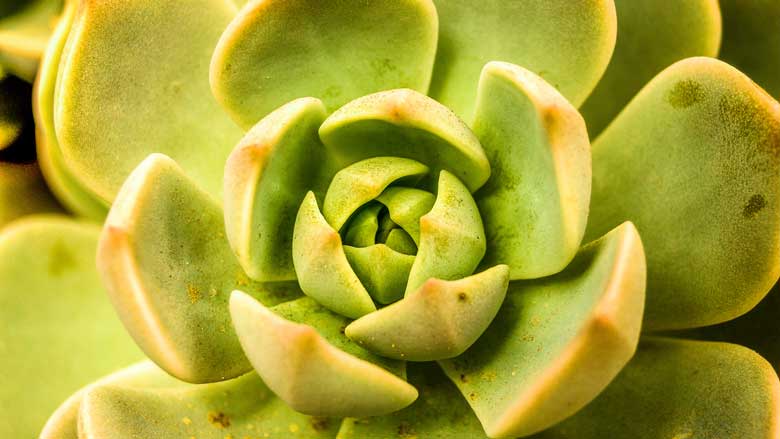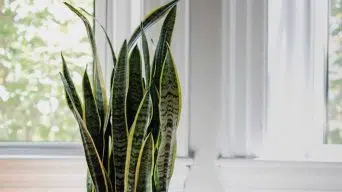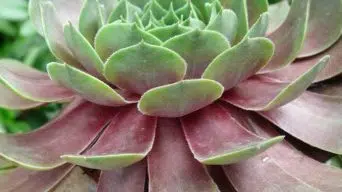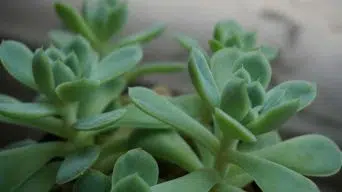Succulent leaves turn yellow due to overwatering, underwatering, excessive sun or shade, overfeeding, pests, nutrient deficiencies, cold temperatures, or root issues. To prevent yellowing, practice optimal watering, ensure adequate light, maintain proper temperature, use well-draining soil, prune regularly, and choose the right pot size. Only remove yellow leaves if wilted, as healthy succulents can recover without intervention.
Succulents are favored as indoor plants due to their low maintenance and aesthetic appeal.
Nonetheless, yellowing succulent leaves may signal the presence of pests, diseases, or succulent growing conditions that need improvement.
Here’s what you should know about this common succulent problem and how to fix it!
Why Do Succulent Plant Leaves Turn Yellow?
Caring for succulents is generally straightforward. However, encountering yellowing leaves can be perplexing if you’re unsure about the reasons behind it and how to address it.
Succulent leaves becoming yellow can be attributed to various factors, and it’s crucial to comprehend these reasons to ensure optimal care for your plant.
Notably, the occurrence of yellow succulent leaves doesn’t always indicate a problem.
Succulents sometimes require a period for their new growth to mature and gain strength. Naturally, a plant undergoes a color-changing process before producing fresh growth.
If your succulents are otherwise healthy, the yellowing leaves might be a natural part of their growth cycle.
The primary reasons behind succulent plant leaves turning yellow include:
1. Overwatering
Succulents can survive long periods without water.
If you overwater your succulent plant, the roots cannot get any oxygen and will begin to rot. If the leaves turn yellow, this is often a sign of overwatering.
You need to stop watering immediately when leaves turn yellow.
If your succulent is too far gone, you may need to remove any dead plants and soil from the container.
Do not water them for at least a week. After this time, if there are new green growths, you can start slowly re-watering your succulent, but only once every two weeks!
Succulent plants only need to be watered when their soil is fully dried out.
2. Underwatering
Another common reason succulent leaves turn yellow is a lack of water!
If your plant is not getting enough water, it will begin to wilt, and the lower leaves may also start turning yellow or brown, with dead plant material at the bottom of your succulent pot.
You need to start watering your plant immediately when the leaves turn yellow.
Feel the soil with your finger to see how dry it is if you are unsure if your succulents are getting enough water.
3. Excessive Sun Exposure
Succulents thrive in bright sunlight, yet excess sun exposure can lead to leaves turning yellow.
Consider relocating your plant to a shadier spot if they are consistently exposed to direct sun throughout the day.
While succulents benefit from a few hours of direct sunlight daily, leaves with a yellow color may indicate a need for increased shade.
Ensure a balance between sunlight and shade to maintain the health and vibrancy of your plants.
4. Insufficient Sunlight
Succulents need sunlight to produce succulent growth.
If your plants are not getting enough light, they may become more pale, and their succulent leaves will start turning yellow or brown, with dead plant material at the bottom of your succulent pot.
You need to move your plant into a brighter location immediately.
5. Overfeeding Succulents
Overfeeding succulents is indicated when their leaves turn yellow, signaling a potential consequence of excessive fertilization.
Frequent feeding can lead to undesirable growth, resulting in the yellowing or browning of lower succulent leaves due to an excess of nutrients from the fertilizer.
If you observe leaves becoming yellow, it is crucial to discontinue feeding immediately.
6. Cold Temperatures
Yellowing leaves and a lack of thriving can indicate that your succulents are experiencing cold temperatures.
In colder climates, the transition between indoor and outdoor environments may pose challenges for succulent plants.
It’s important to note that succulents are not inherently cold-hardy plants. Therefore, it is crucial to bring them indoors before the onset of the first frost.
7. Pest Infestation
Yellowing succulent leaves may indicate a pest infestation, with aphids and mealybugs being prevalent culprits.
However, other succulent-eating insects could also be contributing to the problem.
Immediate action is crucial to prevent further leaves to turn yellow. Treat the affected succulents promptly to address the pest infestation.
8. Nutrient Deficiencies
Plants with yellow leaves often indicate a nutrient deficiency, emphasizing the crucial role of proper soil health for these plants.
Succulents thrive in nutrient-rich soil, and insufficient nutrients can result in the development of unhealthy growth characterized by leaves that look yellow.
To address this issue promptly, you must start fertilizing succulents immediately when their leaves turn yellow.
9. Soil Drainage Issues
Yellow leaves can signal drainage problems in your succulent pot. Inadequate drainage may result in rotting roots or fungal infections, causing succulent leaves to turn yellow and decay.
Immediate repotting is essential to address drainage issues effectively when succulent leaves turn yellow.
10. Root Rot
Yellowing succulent plant leaves may indicate rotting roots, an infection leading to root deterioration.
To ensure succulent health, a well-draining soil mix is crucial. Inadequate watering can trigger the succulent leaves to become yellow.
To address root rot in succulents, cease watering promptly. Allow the succulent potting soil to thoroughly dry before resuming watering.
11. Sudden Temperature Changes
Abrupt temperature fluctuations may result in succulent leaves becoming yellow.
These plants flourish in stable temperatures, making them particularly sensitive to sudden temperature changes.
If you notice yellow foliage on your succulents, transferring them to an indoor environment with more consistent temperatures is imperative.
This adjustment aims to alleviate the adverse effects of rapid temperature fluctuations and enhance the overall health of your plant.
12. Natural Changes
Succulents may turn yellow because they go through life cycles.
It may be normal for succulent leaves to change colors during succulent growth, dormancy, or when succulents naturally die after they have reached the end of their lifecycle or a different stage in growing.
You can help your plant thrive by pruning off any dying succulent leaves.
Preventing Succulent Leaves From Yellowing
Prevention is the best way to maintain succulents with green leaves.
There are many things succulents need to maintain their healthy leaves.
There are many more ways to prevent succulent leaves from turning yellow, but the main things succulents need are:
1. Optimal Watering Practices
Succulents should be watered regularly but must also have time to dry out between waterings.
Succulent plants should only be watered when the top of their soil feels slightly damp.
If you want succulent leaves to stay green, avoid overwatering them by letting them dry out between watering sessions, and succulent leaves will remain green.
2. Ensuring Adequate Light
Succulents should receive at least six hours of sunlight daily if they want succulent leaves to turn green.
If a plant doesn’t get enough light, succulent leaves will turn yellow.
However, succulents should also be kept from direct sun, as succulent leaves can burn when succulents are exposed to too much light.
3. Temperature Considerations
To ensure the well-being of your succulents, maintaining a temperature range of 50 to 90 degrees Fahrenheit, along with humidity levels between 40% and 70%, is crucial.
Succulents are highly sensitive to extreme temperatures, and their survival depends on creating an environment within the specified temperature parameters. It is imperative to shield them from both excessively cold and hot conditions.
The yellowing of succulent leaves serves as a clear indicator that the plants are experiencing stress due to extreme temperatures.
Preserving the vibrant green hue of succulent leaves requires careful regulation of their exposure to light and maintaining an optimal temperature range.
4. Proper Soil Drainage
To ensure the health and vibrancy of your succulents, it’s crucial to plant them in well-draining soil. Inadequate drainage can result in yellowing leaves, compromising the overall vitality of your succulents.
The ideal substrate for these plants is sandy and gritty, facilitating effective drainage.
Consider utilizing a specialized cactus or succulent potting mix, both excellent choices that create an environment conducive to succulent growth.
For succulents to flourish, providing the appropriate level of drainage is paramount. A well-chosen succulent soil not only sustains the plant but also preserves the lush green coloration of its leaves.
5. Pruning for Succulent Health
Regular pruning is essential for the well-being of succulents, primarily to eliminate dead leaves.
To prevent succulent leaves from becoming yellow, it is crucial to ensure the ongoing health of your succulents by consistently removing any dying or aged leaves.
6. Choosing the Right Pot Size
Selecting the correct pot size is essential for the well-being of succulents. These plants flourish when housed in containers that align with the dimensions of their root systems.
Inadequate space may result in yellow foliage, as succulents need ample room for the unhindered water flow and nutrients to their roots.
Yellowing leaves often indicate problems related to either overwatering or under-watering.
Therefore, it is vital to guarantee that succulent plants have the right space to sustain their vibrant green coloration.
Should You Remove Yellow Leaves From Succulents?
When succulent leaves display a yellow hue, it often triggers concern among plant owners. The initial reaction is to pluck the yellowed leaves from the stem promptly.
However, this instinctive response may not be in your succulents’ best interest.
Removing these yellow leaves might inadvertently inflict more harm than good. This action could strip the plants of essential nutrients and expose vital organs to sunlight, which they neither need nor want.
The first step is to ascertain whether the plant leaves are naturally turning yellow or if there is an underlying problem causing the discoloration.
If the yellowing occurs naturally, avoiding immediate removal is advisable.
While succulents may lose some aesthetic appeal with pale yellow leaves instead of vibrant green ones, they can still flourish and grow by absorbing sunlight through their exposed organs.
Succulent leaves that turn yellow are not problematic when the plants are healthy and robust enough to support these nonfunctional, pale succulent parts.
On the other hand, if the yellowing results from improper succulent care, swift corrective action is necessary.
Succulents can rebound from leaf discoloration once the underlying issue is addressed. Moreover, preventing succulent leaves from turning yellow can be achieved through proper care practices.
Consider removing succulent plant leaves only when they are wilting and have completely lost their green coloration. You should refrain from intervention if the succulents still exhibit vibrancy and luster.
You should only prune succulent leaves when succulents have been knocked over or damaged by wind or other external factors.
If your succulents are robust enough to support weight, delay removing healthy leaves.
Succulents can easily recover from leaf loss if they do not shed more than 50% of their leaves.
Should your succulents lose over half of their leaves, treat them as you would withering succulents.
Restore your succulents to their original vitality through proper succulent plant care.
Succulents are highly resilient plants, and providing them with the right care will rejuvenate their health.
If succulents shed leaves naturally, refrain from removing them, as these leaves serve a purpose.
Yellowing succulent leaves are not concerning, given that the succulents are robust enough to support pale, nonfunctional parts.
Revitalize your succulent plants by administering appropriate succulent plant care in the event of leaf loss for any other reason.
Final Thoughts
Succulent leaves can turn yellow for several reasons. However, succulents are hearty plants, and the succulent plant should recover if you correct your care techniques.
If you notice that one or more of your succulents are turning yellow, you will want to look at why it is occurring and how you can fix it.
With succulents being so hearty, they are great plants for those starting their first garden and those gardening for a long time.
In addition to knowing why your succulent plant leaves turn yellow, knowing the best practices when caring for succulents is essential.







